Abstract
OBJECTIVES: To demonstrate the methods of recruitment of a low-income, predominantly African-American study population for the Southern Community Cohort Study (SCCS), a prospective epidemiologic investigation of racial disparities in cancer risk. METHODS: Partnerships with community health centers (CHCs) were formed to reach underserved populations throughout the south. Recruitment of participants (aged 40-79) in CHCs began in March 2002. Participants complete a comprehensive baseline interview and provide a blood or buccal cell sample. Recruitment will expand to the general population of the south to achieve a broad cross-section of socioeconomic status, The final cohort size is expected to be approximately 100,000. RESULTS: A high level of cooperation and recruitment was achieved in the CHCs. From March 2002 to October 2004, 32,632 participants (80% black, 41% male, 62% with total household income < $15,000, 34% with < 12 years schooling) enrolled. Participants reported a high prevalence of medical conditions (21% diabetic, 44% obese) and adverse health behaviors (45% current smokers). CONCLUSIONS: Working in CHCs is successful for recruiting a population that has been difficult to reach in previous studies. The SCCS is a unique cohort that will provide a rich resource for evaluating disparities in cancer and other chronic disease risk as it is followed over time.
Full text
PDF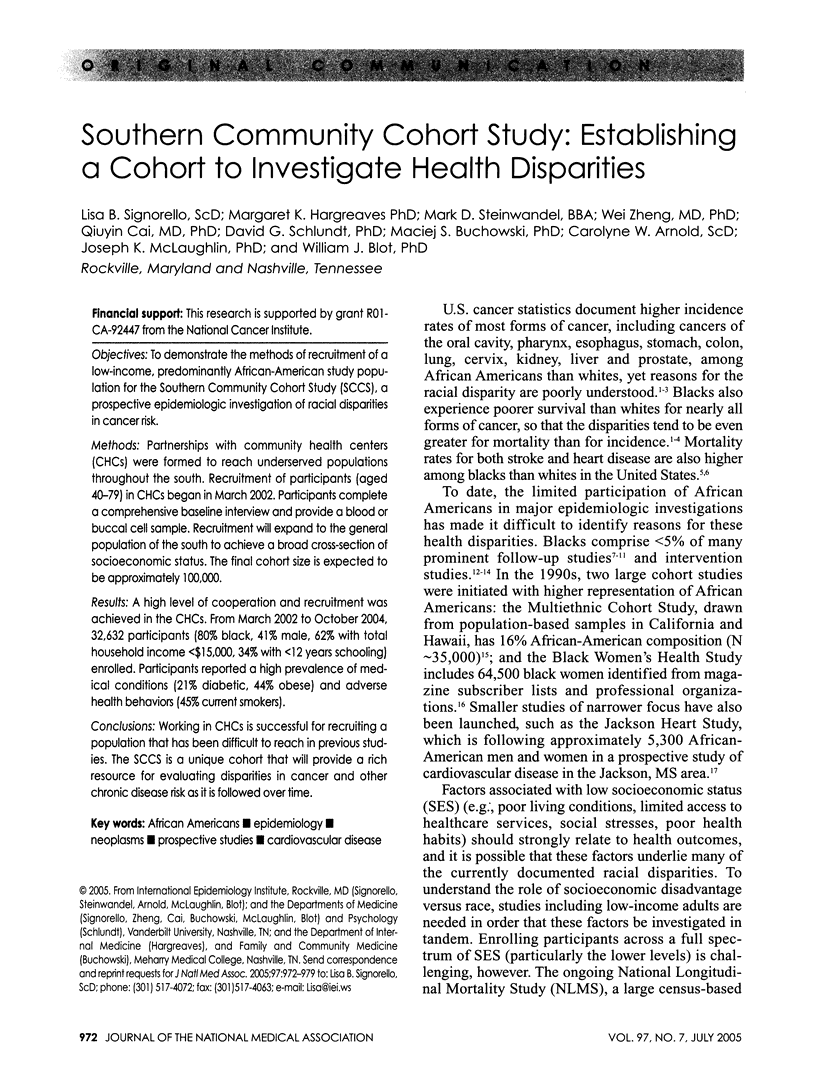
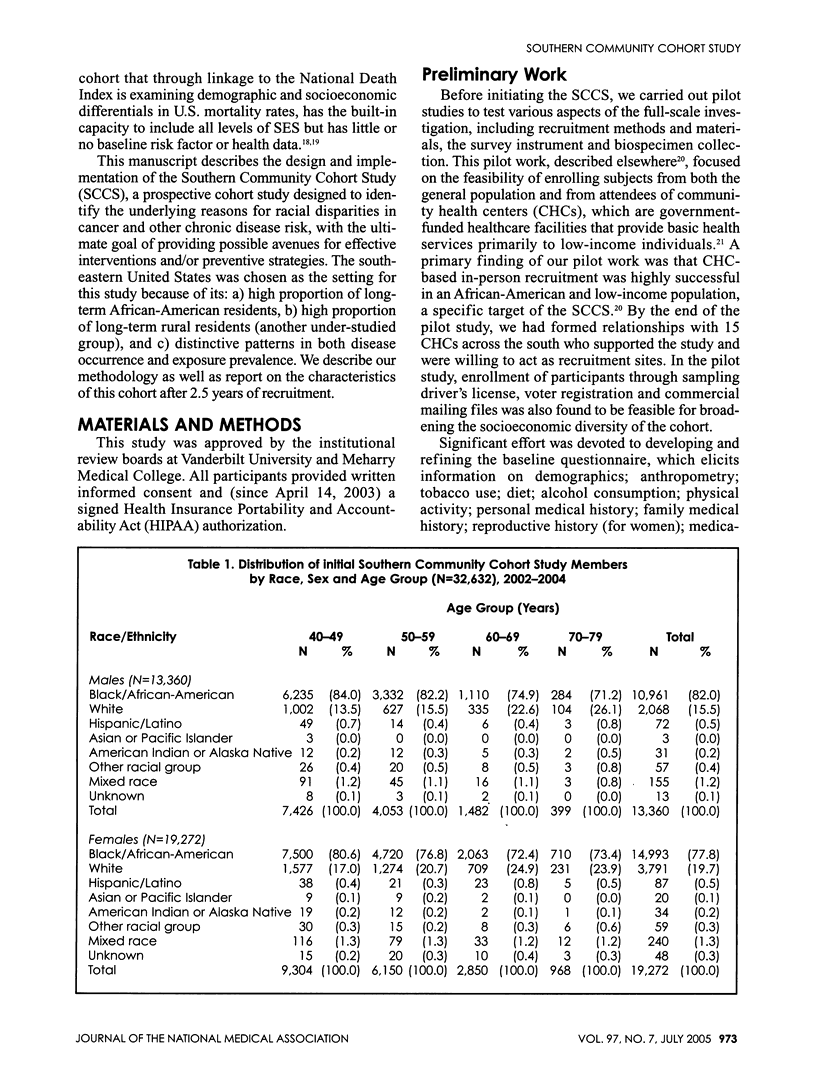
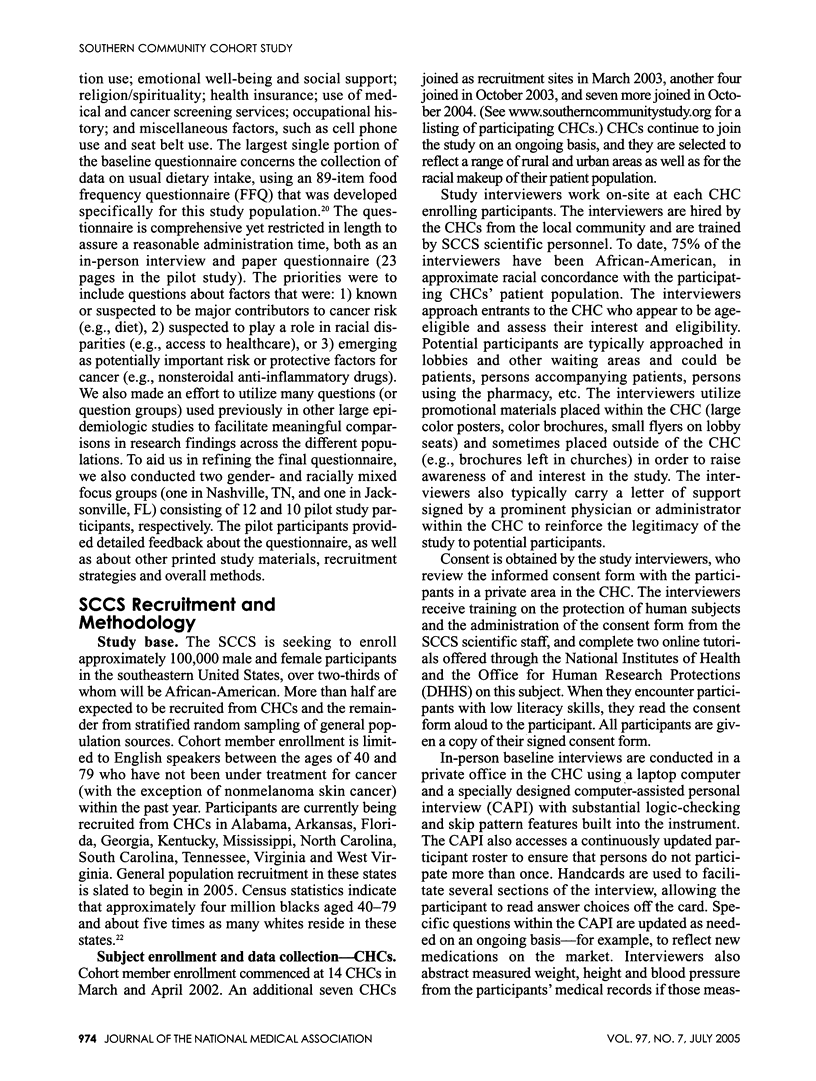
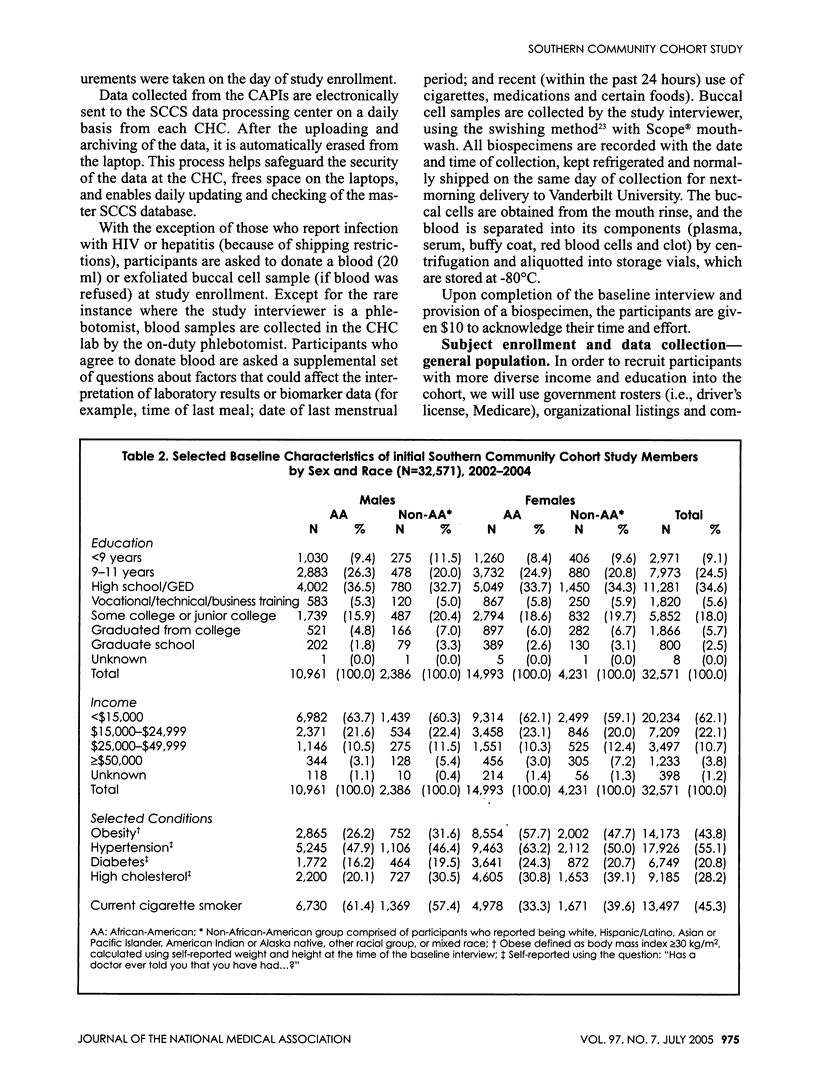

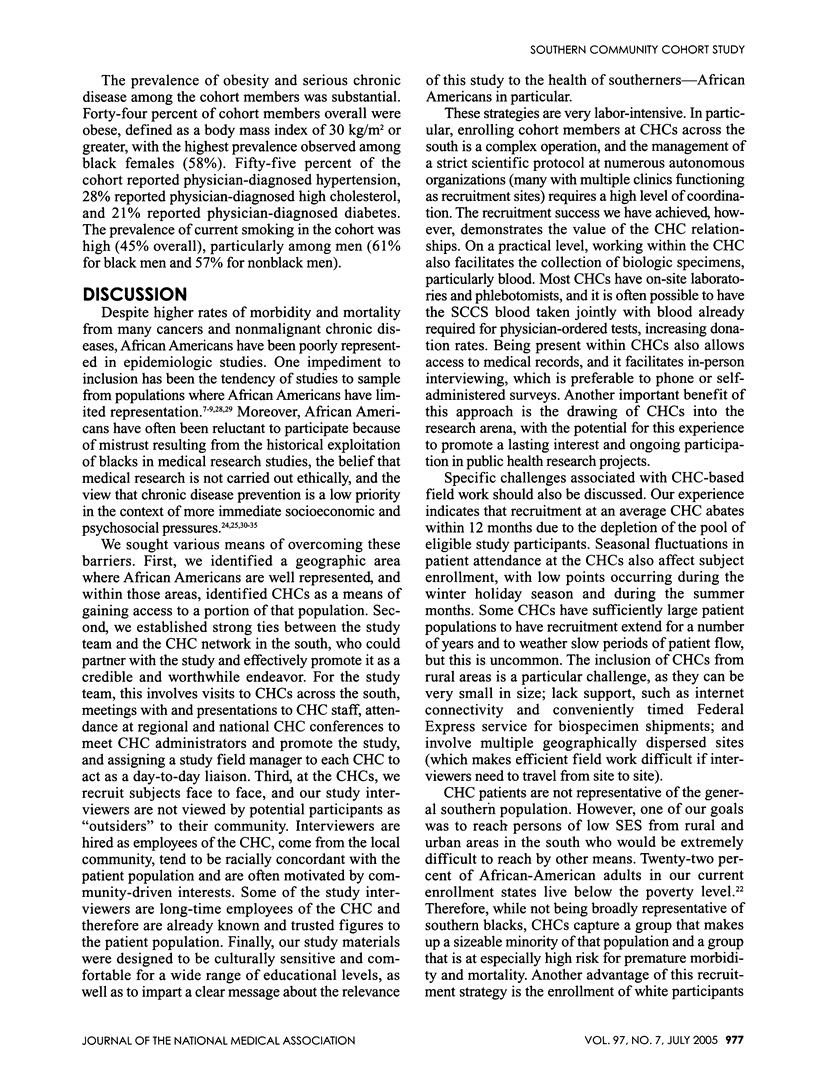

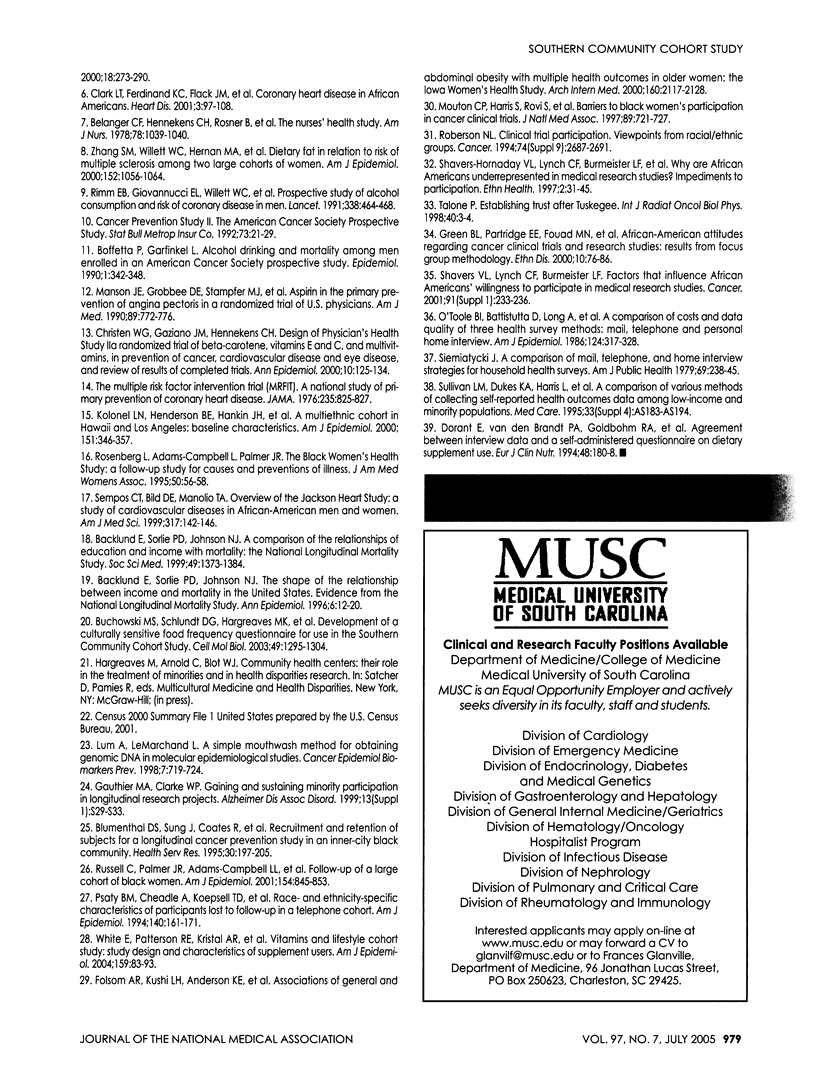
Selected References
These references are in PubMed. This may not be the complete list of references from this article.
- Backlund E., Sorlie P. D., Johnson N. J. A comparison of the relationships of education and income with mortality: the National Longitudinal Mortality Study. Soc Sci Med. 1999 Nov;49(10):1373–1384. doi: 10.1016/s0277-9536(99)00209-9. [DOI] [PubMed] [Google Scholar]
- Belanger C. F., Hennekens C. H., Rosner B., Speizer F. E. The nurses' health study. Am J Nurs. 1978 Jun;78(6):1039–1040. [PubMed] [Google Scholar]
- Blumenthal D. S., Sung J., Coates R., Williams J., Liff J. Recruitment and retention of subjects for a longitudinal cancer prevention study in an inner-city black community. Health Serv Res. 1995 Apr;30(1 Pt 2):197–205. [PMC free article] [PubMed] [Google Scholar]
- Buchowski M. S., Schlundt D. G., Hargreaves M. K., Hankin J. H., Signorello L. B., Blot W. J. Development of a culturally sensitive food frequency questionnaire for use in the Southern Community Cohort Study. Cell Mol Biol (Noisy-le-grand) 2003 Dec;49(8):1295–1304. [PubMed] [Google Scholar]
- Christen W. G., Gaziano J. M., Hennekens C. H. Design of Physicians' Health Study II--a randomized trial of beta-carotene, vitamins E and C, and multivitamins, in prevention of cancer, cardiovascular disease, and eye disease, and review of results of completed trials. Ann Epidemiol. 2000 Feb;10(2):125–134. doi: 10.1016/s1047-2797(99)00042-3. [DOI] [PubMed] [Google Scholar]
- Clark L. T., Ferdinand K. C., Flack J. M., Gavin J. R., 3rd, Hall W. D., Kumanyika S. K., Reed J. W., Saunders E., Valantine H. A., Watson K. Coronary heart disease in African Americans. Heart Dis. 2001 Mar-Apr;3(2):97–108. doi: 10.1097/00132580-200103000-00007. [DOI] [PubMed] [Google Scholar]
- Dorant E., van den Brandt P. A., Goldbohm R. A., Hermus R. J., Sturmans F. Agreement between interview data and a self-administered questionnaire on dietary supplement use. Eur J Clin Nutr. 1994 Mar;48(3):180–188. [PubMed] [Google Scholar]
- Folsom A. R., Kushi L. H., Anderson K. E., Mink P. J., Olson J. E., Hong C. P., Sellers T. A., Lazovich D., Prineas R. J. Associations of general and abdominal obesity with multiple health outcomes in older women: the Iowa Women's Health Study. Arch Intern Med. 2000 Jul 24;160(14):2117–2128. doi: 10.1001/archinte.160.14.2117. [DOI] [PubMed] [Google Scholar]
- Gauthier M. A., Clarke W. P. Gaining and sustaining minority participation in longitudinal research projects. Alzheimer Dis Assoc Disord. 1999 Apr-Jun;13 (Suppl 1):S29–S33. doi: 10.1097/00002093-199904001-00008. [DOI] [PubMed] [Google Scholar]
- Green B. L., Partridge E. E., Fouad M. N., Kohler C., Crayton E. F., Alexander L. African-American attitudes regarding cancer clinical trials and research studies: results from focus group methodology. Ethn Dis. 2000 Winter;10(1):76–86. [PubMed] [Google Scholar]
- Jemal Ahmedin, Tiwari Ram C., Murray Taylor, Ghafoor Asma, Samuels Alicia, Ward Elizabeth, Feuer Eric J., Thun Michael J., American Cancer Society Cancer statistics, 2004. CA Cancer J Clin. 2004 Jan-Feb;54(1):8–29. doi: 10.3322/canjclin.54.1.8. [DOI] [PubMed] [Google Scholar]
- Kolonel L. N., Henderson B. E., Hankin J. H., Nomura A. M., Wilkens L. R., Pike M. C., Stram D. O., Monroe K. R., Earle M. E., Nagamine F. S. A multiethnic cohort in Hawaii and Los Angeles: baseline characteristics. Am J Epidemiol. 2000 Feb 15;151(4):346–357. doi: 10.1093/oxfordjournals.aje.a010213. [DOI] [PMC free article] [PubMed] [Google Scholar]
- Lum A., Le Marchand L. A simple mouthwash method for obtaining genomic DNA in molecular epidemiological studies. Cancer Epidemiol Biomarkers Prev. 1998 Aug;7(8):719–724. [PubMed] [Google Scholar]
- Manson J. E., Grobbee D. E., Stampfer M. J., Taylor J. O., Goldhaber S. Z., Gaziano J. M., Ridker P. M., Buring J. E., Hennekens C. H. Aspirin in the primary prevention of angina pectoris in a randomized trial of United States physicians. Am J Med. 1990 Dec;89(6):772–776. doi: 10.1016/0002-9343(90)90220-8. [DOI] [PubMed] [Google Scholar]
- Mouton C. P., Harris S., Rovi S., Solorzano P., Johnson M. S. Barriers to black women's participation in cancer clinical trials. J Natl Med Assoc. 1997 Nov;89(11):721–727. [PMC free article] [PubMed] [Google Scholar]
- O'Toole B. I., Battistutta D., Long A., Crouch K. A comparison of costs and data quality of three health survey methods: mail, telephone and personal home interview. Am J Epidemiol. 1986 Aug;124(2):317–328. doi: 10.1093/oxfordjournals.aje.a114390. [DOI] [PubMed] [Google Scholar]
- Psaty B. M., Cheadle A., Koepsell T. D., Diehr P., Wickizer T., Curry S., VonKorff M., Perrin E. B., Pearson D. C., Wagner E. H. Race- and ethnicity-specific characteristics of participants lost to follow-up in a telephone cohort. Am J Epidemiol. 1994 Jul 15;140(2):161–171. doi: 10.1093/oxfordjournals.aje.a117226. [DOI] [PubMed] [Google Scholar]
- Rimm E. B., Giovannucci E. L., Willett W. C., Colditz G. A., Ascherio A., Rosner B., Stampfer M. J. Prospective study of alcohol consumption and risk of coronary disease in men. Lancet. 1991 Aug 24;338(8765):464–468. doi: 10.1016/0140-6736(91)90542-w. [DOI] [PubMed] [Google Scholar]
- Roberson N. L. Clinical trial participation. Viewpoints from racial/ethnic groups. Cancer. 1994 Nov 1;74(9 Suppl):2687–2691. doi: 10.1002/1097-0142(19941101)74:9+<2687::aid-cncr2820741817>3.0.co;2-b. [DOI] [PubMed] [Google Scholar]
- Rosenberg L., Adams-Campbell L., Palmer J. R. The Black Women's Health Study: a follow-up study for causes and preventions of illness. J Am Med Womens Assoc. 1995 Mar-Apr;50(2):56–58. [PubMed] [Google Scholar]
- Russell C., Palmer J. R., Adams-Campbell L. L., Rosenberg L. Follow-up of a large cohort of Black women. Am J Epidemiol. 2001 Nov 1;154(9):845–853. doi: 10.1093/aje/154.9.845. [DOI] [PubMed] [Google Scholar]
- Sempos C. T., Bild D. E., Manolio T. A. Overview of the Jackson Heart Study: a study of cardiovascular diseases in African American men and women. Am J Med Sci. 1999 Mar;317(3):142–146. doi: 10.1097/00000441-199903000-00002. [DOI] [PubMed] [Google Scholar]
- Shavers-Hornaday V. L., Lynch C. F., Burmeister L. F., Torner J. C. Why are African Americans under-represented in medical research studies? Impediments to participation. Ethn Health. 1997 Mar-Jun;2(1-2):31–45. doi: 10.1080/13557858.1997.9961813. [DOI] [PubMed] [Google Scholar]
- Shavers V. L., Lynch C. F., Burmeister L. F. Factors that influence African-Americans' willingness to participate in medical research studies. Cancer. 2001 Jan 1;91(1 Suppl):233–236. doi: 10.1002/1097-0142(20010101)91:1+<233::aid-cncr10>3.0.co;2-8. [DOI] [PubMed] [Google Scholar]
- Siemiatycki J. A comparison of mail, telephone, and home interview strategies for household health surveys. Am J Public Health. 1979 Mar;69(3):238–245. doi: 10.2105/ajph.69.3.238. [DOI] [PMC free article] [PubMed] [Google Scholar]
- Ward Elizabeth, Jemal Ahmedin, Cokkinides Vilma, Singh Gopal K., Cardinez Cheryll, Ghafoor Asma, Thun Michael. Cancer disparities by race/ethnicity and socioeconomic status. CA Cancer J Clin. 2004 Mar-Apr;54(2):78–93. doi: 10.3322/canjclin.54.2.78. [DOI] [PubMed] [Google Scholar]
- White Emily, Patterson Ruth E., Kristal Alan R., Thornquist Mark, King Irena, Shattuck Ann L., Evans Ilonka, Satia-Abouta Jessie, Littman Alyson J., Potter John D. VITamins And Lifestyle cohort study: study design and characteristics of supplement users. Am J Epidemiol. 2004 Jan 1;159(1):83–93. doi: 10.1093/aje/kwh010. [DOI] [PubMed] [Google Scholar]
- Zhang S. M., Willett W. C., Hernán M. A., Olek M. J., Ascherio A. Dietary fat in relation to risk of multiple sclerosis among two large cohorts of women. Am J Epidemiol. 2000 Dec 1;152(11):1056–1064. doi: 10.1093/aje/152.11.1056. [DOI] [PubMed] [Google Scholar]


